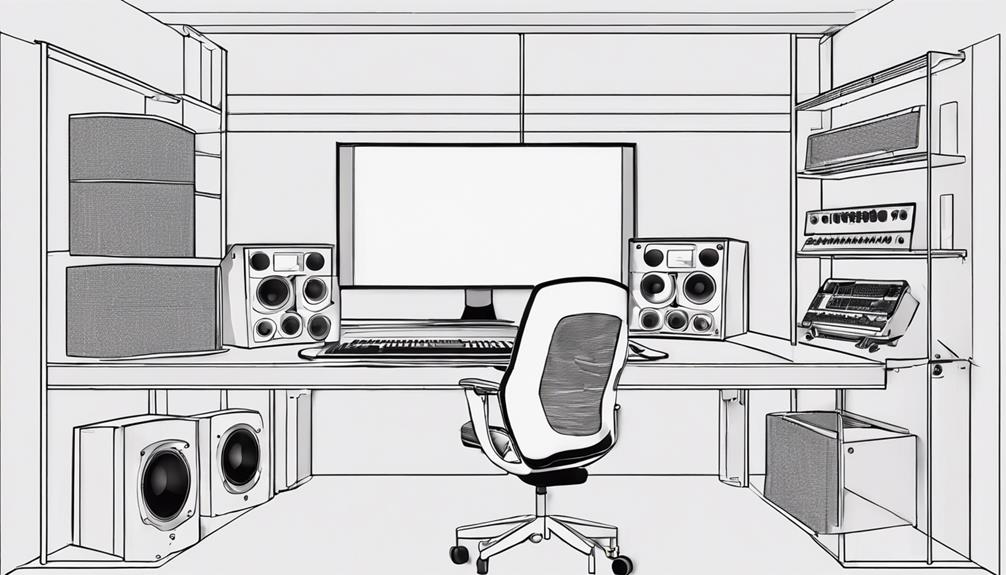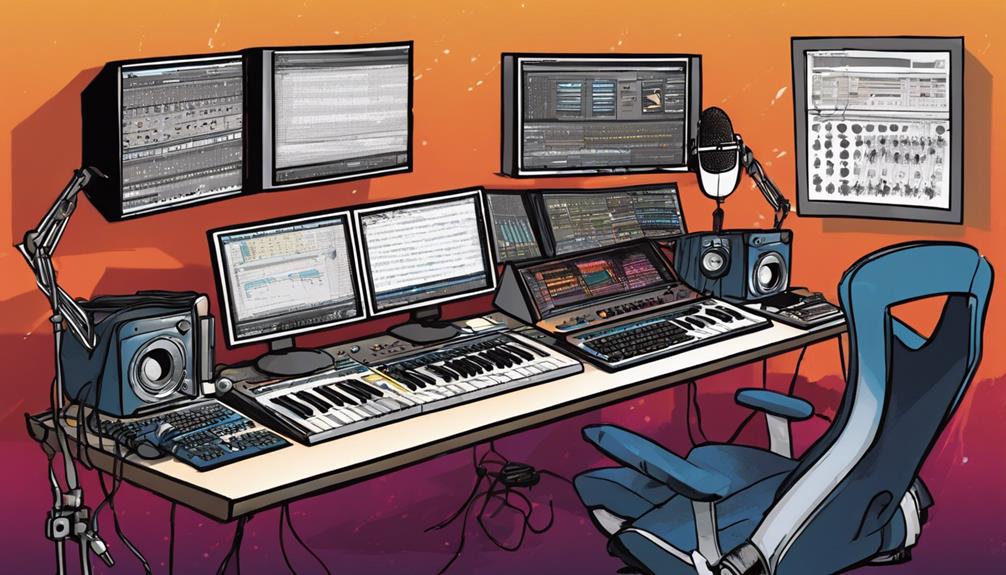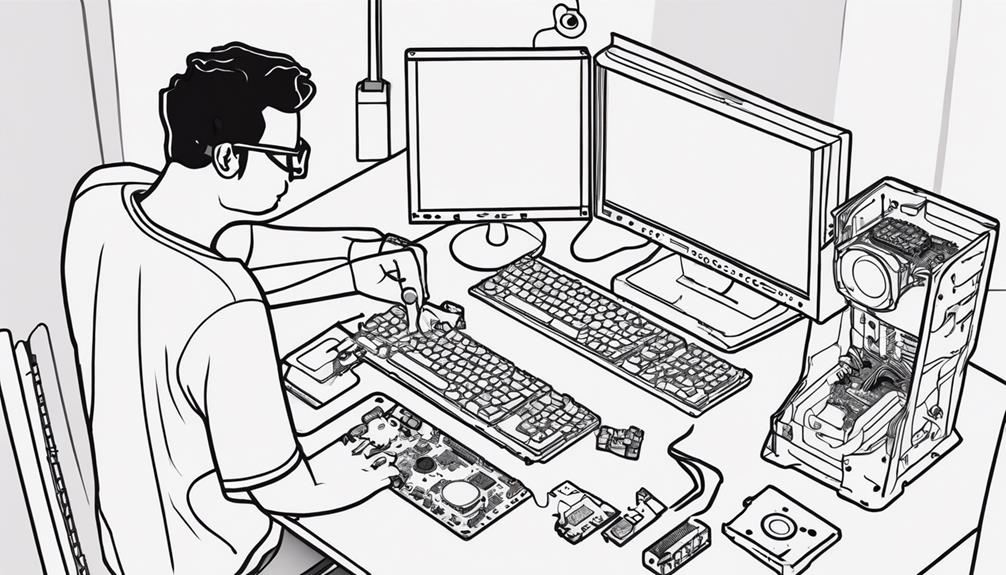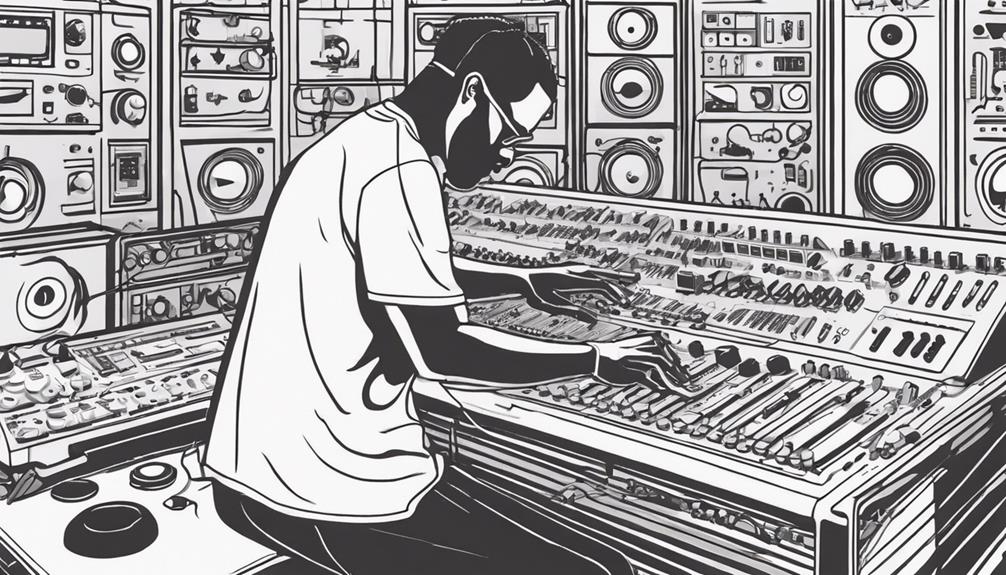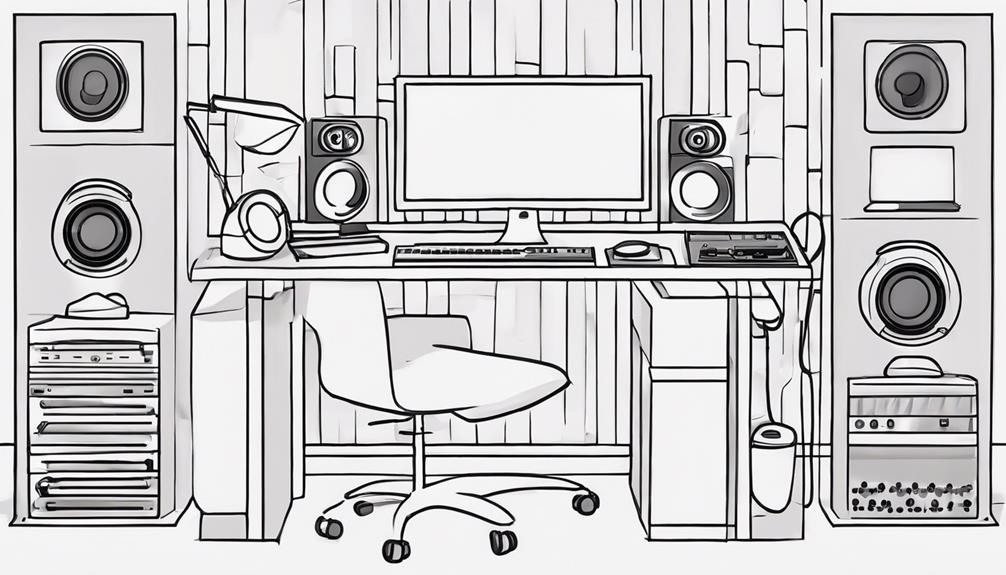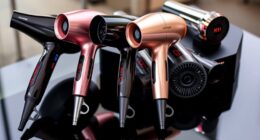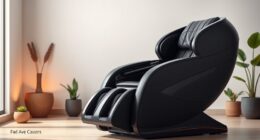Craft your personalized music production desk by following a detailed DIY guide. Gather materials like MDF, supports, and a bamboo countertop. Consider dimensions carefully for stability and comfort. Prepare your workspace with ample lighting and organization. Cut and sand the wood precisely for a flawless finish. Assemble the frame securely and install the countertop accurately. Finish off with sanding, priming, and painting for durability. Gain insights into cost breakdown and final touches. Explore the steps further to build a functional and stylish desk just for you.
Key Takeaways
- Use 3/4 inch MDF & bamboo countertop for stability and sleek finish.
- Customize desk height for ergonomic comfort.
- Optimize workflow with spacious design for gear organization.
- Secure frame with proper spacing and supports for stability.
- Sand, prime, paint, and seal for a durable, professional finish.
Materials Needed
To construct a music production desk, gather 3/4 inch MDF, 2×3 supports, a 1×8 back support, and a bamboo countertop. These materials form the foundation for your DIY project.
The use of 3/4 inch MDF guarantees a robust structure, while the 2×3 supports provide stability to the desk. Additionally, incorporating a 1×8 back support adds further reinforcement to the design, ensuring durability over time.
When working on your music production desk, remember to cut specific measurements such as 35.5-inch squares for the desk itself. For accommodating rack mount gear, the inner spacing should be set at 19 1/16 inches.
Lastly, the choice of a bamboo countertop not only adds a sleek finish to the desk but also provides a smooth surface for your equipment.
Desk Design Considerations
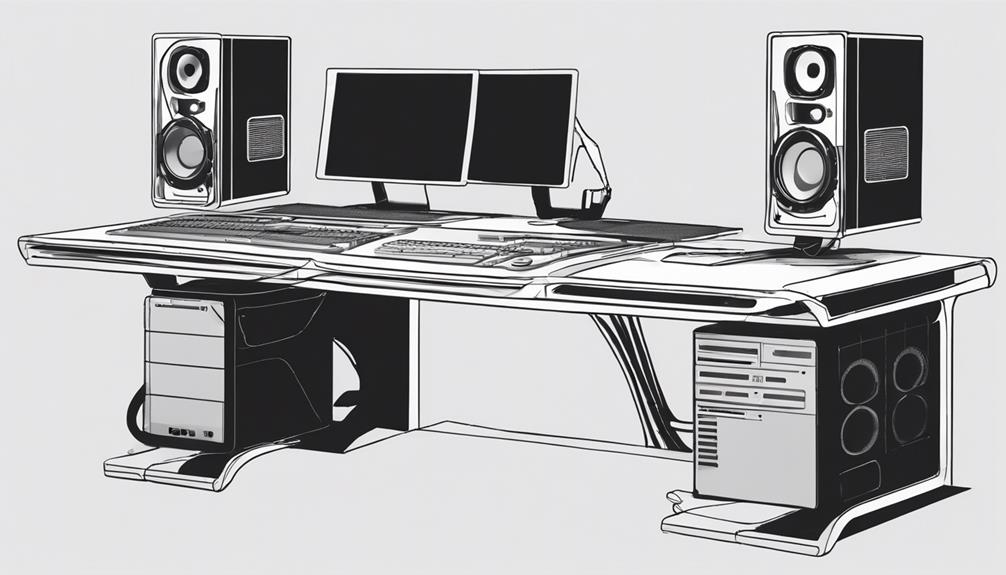
Considering the width of your desk is important to guarantee all your gear remains within easy reach during your music production sessions. When designing your studio desk, make sure that it accommodates the width of your equipment, such as your computer, MIDI controllers, and audio interfaces. This setup will optimize your workflow by keeping everything you need nearby.
Another significant aspect to take into account is easy access to rack space from your sweet spot. This allows you to adjust your gear and settings conveniently without disrupting your creative process.
Additionally, opt for a design that provides stability, especially if you have heavy equipment like studio monitors or multiple screens.
Customizing the desk height is crucial for your comfort and working preferences. Ensure the desk is ergonomically suitable to prevent strain during long hours of music production.
Preparing the Workspace
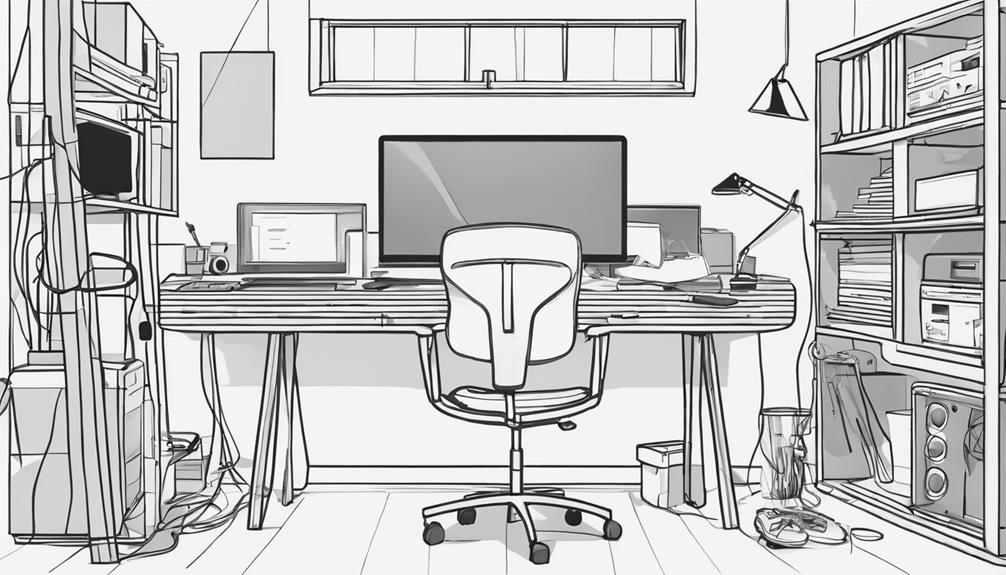
Clear out a spacious area in your workspace to accommodate the size of the desk you plan to build before starting the construction process. Guarantee that your workspace has proper lighting and ventilation for a comfortable working environment during the construction phase.
Have all necessary tools and materials organized and easily accessible within your workspace to facilitate efficient assembly. Consider using a drop cloth or protective covering to prevent any damage to the floor or surrounding surfaces while you work on building the desk. Double-check measurements and plans in your workspace to avoid mistakes and ensure a smooth construction process.
Cutting and Sanding the Wood
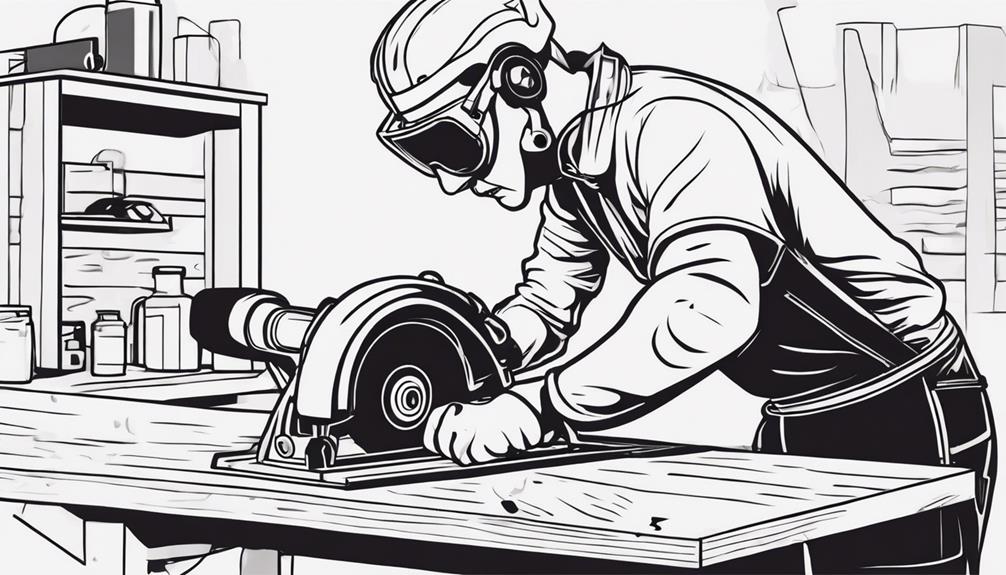
Measure and mark the birch butcher block with precision before making the necessary cuts to create your studio desk's main desktop.
Use a circular saw with a fine-tooth blade for accurate dimensions and then sand the edges and surfaces with fine-grit sandpaper for a smooth finish.
Don't forget to round off the corners for a polished look and wipe down the wood to remove any debris before moving on to staining. Don’t forget to round off the corners for a polished look and wipe down the wood to remove any debris before moving on to staining. Choosing the right stain color can make all the difference in enhancing the natural grain of the wood, so take your time to test a few samples beforehand. If you’re uncertain, you can always find inspiration from places like Doremi Picnic Meadow directions, where nature’s hues offer a perfect guide for earthy tones. Once you’ve selected your stain, apply it evenly and let it set for a rich, long-lasting finish.
Wood Measurements and Cuts
To guarantee a sturdy and professional-looking music production desk, accurately cut 35.5-inch squares of 3/4 inch MDF for the main desktop using precise measurements. The table below outlines the measurements needed for key components of the desk:
| Component | Material | Measurement |
|---|---|---|
| Main Desktop | 3/4 inch MDF | 35.5-inch squares |
| Inner Spacing for Gear | 3/4 inch MDF | 19 1/16 inches |
| Cross Supports | 2×3 | Custom lengths |
| Back Support | 1×8 | Custom lengths |
Ensure that the inner spacing for rack mount gear is accurately cut to 19 1/16 inches to accommodate your equipment. Use 2×3 for the cross supports to provide stability and 1×8 for the back support to reinforce the structure. Remember, precise measurements and clean cuts are essential for both the structural integrity and the visual appeal of your music production desk.
Sanding for Smoothness
Smooth out any rough surfaces and imperfections by sanding the wood before staining your music production desk.
Begin with coarser sandpaper, around 80 to 120 grit, for initial sanding to remove any prominent flaws. Make sure to follow the wood grain's direction to avoid creating scratches and maintain a uniform surface.
As you progress, switch to finer sandpaper, such as 220 to 400 grit, for a smoother finish. Thoroughly clean the wood after sanding to eliminate all dust and debris, ensuring a pristine base for staining.
Finishing Touches
When cutting and sanding the wood for your music production desk, prioritize precision and attention to detail to guarantee a professional and polished finish.
Start by measuring twice and cutting once to make sure accurate dimensions for each wood piece. Use a high-quality saw with a fine-tooth blade to make clean and precise cuts, reducing the risk of errors during assembly.
After cutting, sand the edges of the wood pieces to eliminate splinters and rough spots, creating a smooth surface for a refined look. Focus on the corners and edges while sanding to maintain a uniform appearance across the entire desk.
Smooth and properly finished wood not only enhances the aesthetics of your desk but also improves its durability and longevity. Remember, the effort put into cutting and sanding the wood will greatly impact the overall quality and appearance of your music production desk.
Assembling the Desk Frame
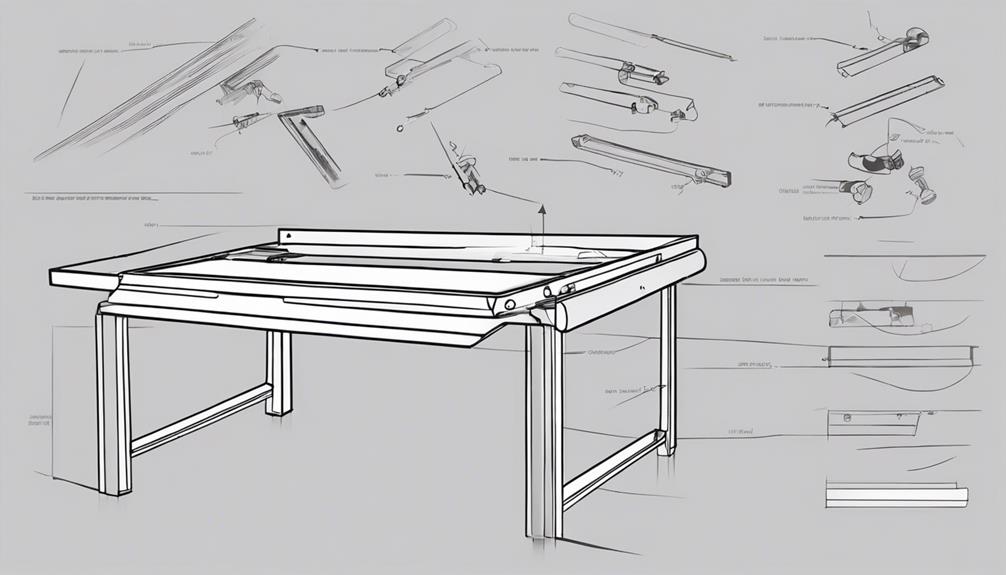
Begin by spacing out the side racks evenly to guarantee structural integrity and proper alignment when assembling the desk frame. This step is essential in ensuring that the desk frame is stable and can support the weight of your music production equipment.
Once the side racks are in position, secure them using half-inch screws and additional brackets for added stability during use.
Next, carefully place the desktop on the assembled side racks, making sure it fits snugly to create a solid foundation for your music gear. Use support pieces to attach the desktop to the side racks securely. This will provide a sturdy work surface for your equipment.
Before proceeding with the final touches, double-check the desk frame to ensure it's level. Make any necessary adjustments to guarantee a stable and balanced desk for your music production needs.
Following these steps will help you assemble a reliable and durable music production desk.
Adding Rack Mount Gear Spacing
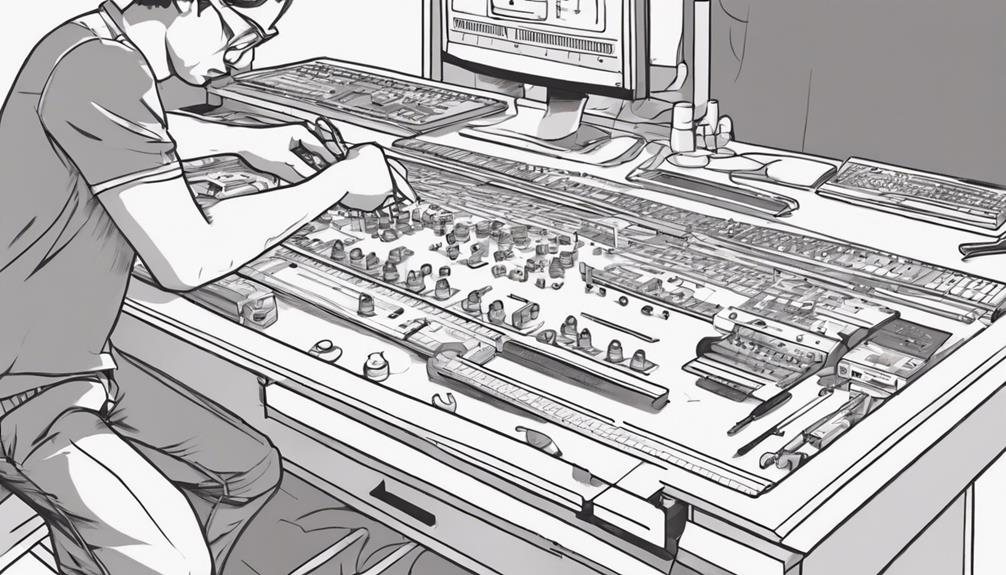
To optimize your music production desk for rack mount gear spacing, determine the inner spacing needed for your equipment, typically around 19 1/16 inches.
When adding rack mount gear spacing to your desk, consider the following:
- Use 2×3 Cross Supports: Incorporate 2×3 pieces for cross supports to guarantee stability for your rack mount gear.
- Sturdy Back Support: Utilize a 1×8 back support to hold the sides together securely, especially when heavier gear is placed on the rack.
- Wider Surface: Create a wider desk surface to accommodate all your gear on the same table, allowing for easy access and better organization of your equipment.
- Accessibility Optimization: Optimize the design to make sure that the rack space is easily accessible from the sweet spot of your music production setup, enhancing workflow efficiency and convenience.
Installing the Countertop
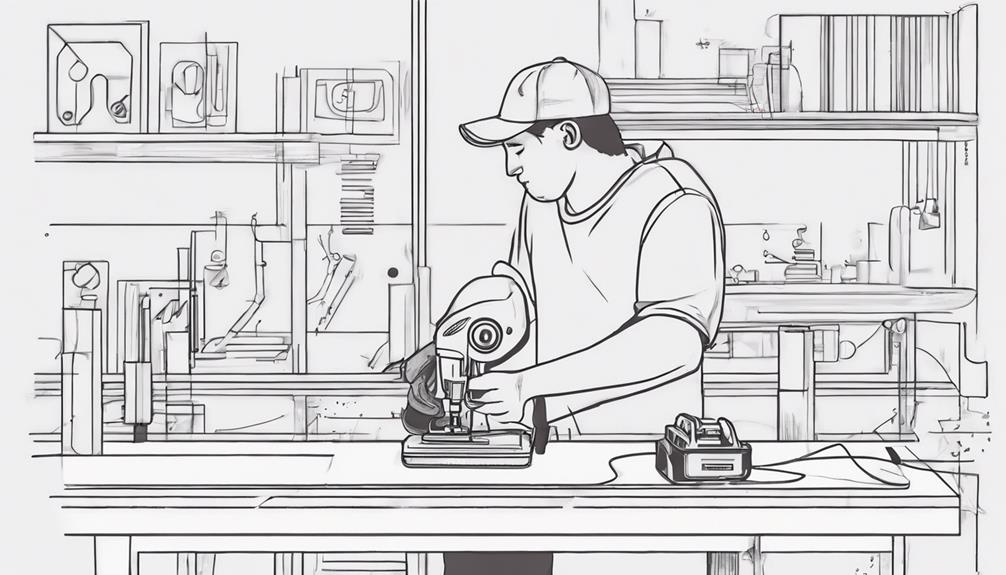
Consider securing the countertop onto the assembled desk frame using screws or a suitable adhesive for a stable work surface.
Before attaching the countertop, make sure you have accurately measured its dimensions to guarantee a perfect fit. Once positioned, use screws or adhesive to firmly attach the countertop, ensuring it's level and flush with the edges of the desk for a polished look.
To enhance the durability of your countertop, seal its edges to safeguard against moisture damage and wear over time.
After installation, test the stability by applying pressure and making any necessary adjustments for a sturdy work surface. Maintaining a secure attachment won't only provide a reliable workspace for your music production needs but also add a professional touch to your DIY desk project.
Follow these steps diligently to create a functional and aesthetically pleasing music production desk.
Sanding, Priming, and Painting
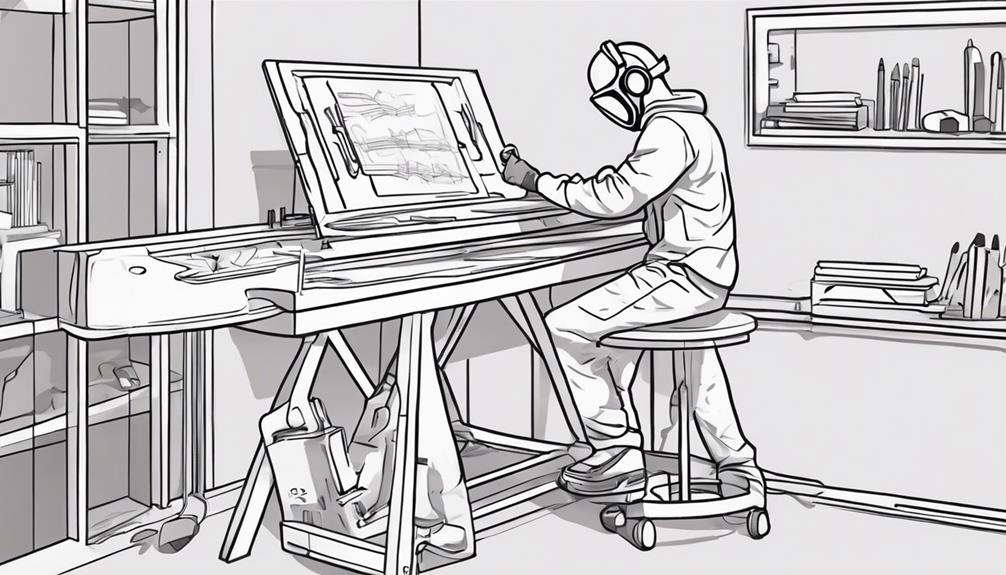
You're about to tackle the essential steps of sanding, priming, and painting your music production desk.
Sanding will guarantee a smooth surface, while using an acrylic-based primer is key for proper paint adhesion.
Sanding Techniques
Smooth out imperfections in the wood surface by starting with an initial sanding using fine grit sandpaper before applying primer and paint for your music production desk. Essential sanding techniques are vital for achieving a professional finish.
Here are some tips to help you sand effectively:
- Begin with a fine grit sandpaper (around 120-220) for the initial sanding process.
- Use a super fine grit sandpaper (around 320-400) for a smoother finish before applying primer and paint.
- Guarantee even sanding to help the primer adhere better to the wood surface.
- Remember to sand between paint layers to remove imperfections and achieve a polished, smooth final look for your music production desk.
Priming Importance
Before painting your music production desk, make sure you understand the critical significance of priming the surface to achieve a flawless finish. Priming plays a key role in preparing the desk for painting by sealing the surface and enhancing paint adhesion.
By sanding the desk beforehand, you create a smooth canvas for the primer to adhere to, ensuring a uniform base for the paint application. This step is especially vital for MDF surfaces, as it prevents the material from absorbing paint unevenly, leading to a blotchy finish.
Opt for an acrylic-based primer and apply it in thin coats to effectively seal the surface and improve the overall durability of the paint job. Proper priming not only enhances the aesthetic appeal of your desk but also reduces the number of paint coats needed to achieve a professional look.
Painting Tips
Prepare your music production desk for a flawless finish by following these essential painting tips, including sanding, priming, and painting techniques.
Before painting, establish a smooth surface by sanding thoroughly to improve paint adhesion. Use an acrylic-based primer on MDF surfaces to help the paint adhere evenly and prevent blotching.
When painting, apply multiple thin coats of paint for a professional and durable finish. To achieve a polished look, remember to sand between paint layers using fine-grit sandpaper.
Attention to detail during the painting process is vital to guarantee a professional appearance for your finished music production desk.
- Sanding before painting is essential for a smooth surface.
- Use an acrylic-based primer on MDF surfaces for even paint adhesion.
- Apply multiple thin coats of paint for a professional finish.
- Sand between paint layers with fine-grit sandpaper for a polished look.
Staining and Finishing Touches
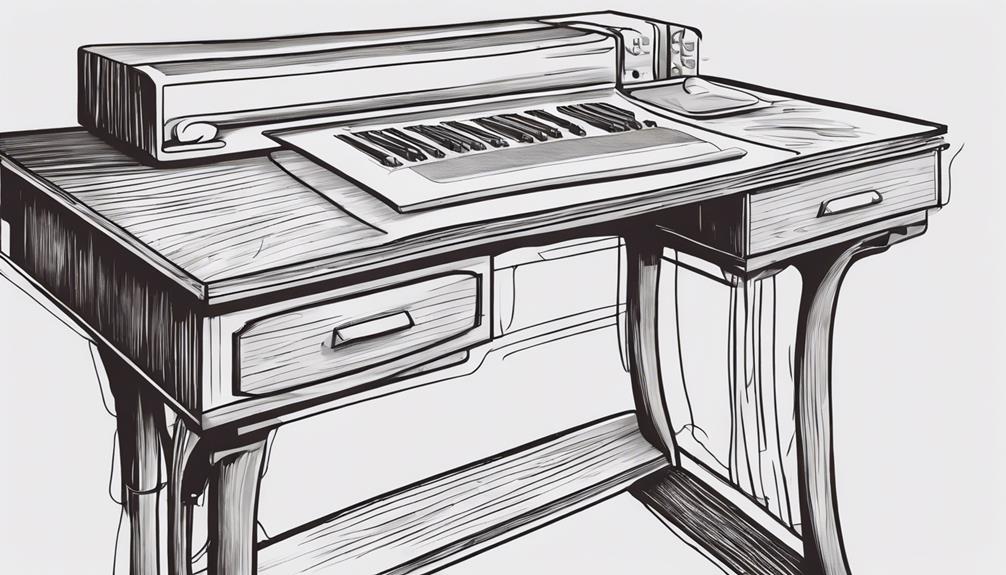
Consider pouring gel stain onto the surface of your music production desk and spreading it evenly with a dry cloth to achieve a consistent finish. When staining, keep in mind that applying multiple layers of gel stain can result in a darker color, but be cautious to prevent excess buildup.
After achieving the desired hue, a clear protective coat can be added to provide durability and a refined appearance. To guarantee a professional look, sanding between each layer of stain is recommended for a smooth texture.
Detail-oriented work during the staining process is vital for obtaining the desired aesthetic for your music production desk. Taking the time to apply the stain evenly and paying attention to any imperfections will contribute to a polished final result.
Cost Breakdown and Final Thoughts
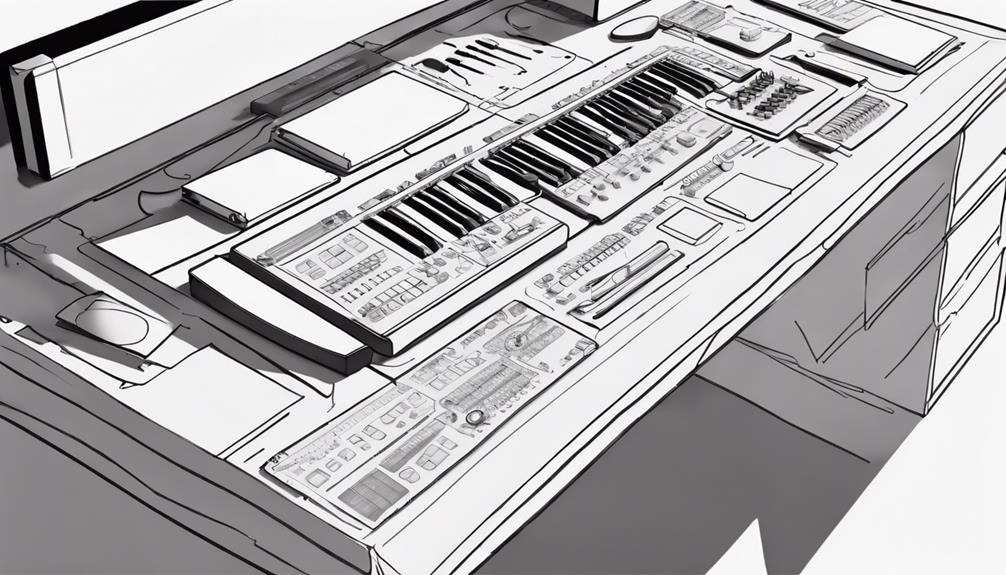
You're probably curious about how the costs break down for your DIY music production desk.
Let's discuss the budget breakdown analysis, tips for saving money, and the key takeaway points to think about as you undertake this project.
Budget Breakdown Analysis
For a thorough understanding of the cost breakdown and final reflections on constructing a music production desk, let's explore the budget breakdown analysis.
The total cost for a DIY music production desk amounts to approximately $544.32, with the primary expenses being:
- Wood at $344.78
- Hardware at $52.11
- Tools at $49.97
- Stain at $19.98
- Miscellaneous items at $77.48
By choosing to build your own desk, you can save substantially compared to buying a pre-built one, which can cost between $1,000 to $2,500. Constructing a music production desk from wood allows for customization, cost-effectiveness, and a sense of accomplishment in creating a workspace tailored to your needs.
The DIY approach not only saves money but also offers a rewarding experience, providing a unique and personalized solution that meets your specific requirements.
- Wood: The most significant cost, allowing for customization and durability.
- Hardware: Essential for assembling the desk securely.
- Tools: Necessary for the construction process.
- Miscellaneous items: Additional components that enhance functionality.
Tips for Saving
To save on costs while building your music production desk, prioritize sourcing materials from budget-friendly suppliers. Seek out deals at local hardware stores, online marketplaces, or salvage yards to score discounts on wood, stain, hardware, tools, and miscellaneous items.
By being strategic in your material sourcing, you can greatly reduce the overall expenses associated with constructing your DIY music production desk. Additionally, consider repurposing materials from old furniture or items you already have to further cut down on costs.
Remember, the total estimated cost for building a DIY music production desk is approximately $544.32, which is a substantial saving compared to purchasing a pre-made studio desk. Embracing the DIY approach not only allows for customization but also frees up budget for investing in other studio equipment or upgrades.
Key Takeaway Points
When starting a DIY music production desk, being mindful of the cost breakdown and final thoughts is essential for a successful project. Here are some key points to keep in mind:
- Cost Breakdown: Understanding the breakdown of costs, including materials like wood, stain, hardware, tools, and miscellaneous items, is vital for budgeting your DIY music production desk project effectively.
- Cost-Effectiveness: Opting for a DIY music production desk can be a cost-effective choice compared to purchasing one, with the total materials cost ranging from $500 to $650 CAD.
- Attention to Detail: Ensuring precise measurements, cuts, and attention to detail will result in a professional-looking DIY music production desk that meets your needs.
- Customization: Take advantage of customization options to incorporate your personal preferences and design ideas into the DIY music production desk, making it uniquely yours.
Keep these key points in mind as you start on your DIY music production desk project, and enjoy the process of creating a workspace tailored to your music production needs.
Frequently Asked Questions
How Do You Set up a Room for Music Production?
To set up a room for music production, position your desk in the center for balanced acoustics. Add sound-absorbing panels, a monitor isolation pad, adjustable lighting, and a rug for improved audio quality, vibration prevention, comfort, and acoustics.
How Much Does It Cost to Build a Music Production Studio?
To build a music production studio, it can cost around $500-$650 CAD. This includes materials like MDF, hardware, paint, and a bamboo countertop. Opting for DIY can save you a lot compared to buying a ready-made desk.
How to Build a Music Studio Pc?
To construct a music studio PC, choose a powerful processor, ample RAM, fast SSD, and dedicated graphics card. Research best configurations balancing performance and budget. Select a reliable motherboard with adequate connectivity. Guarantee proper cooling and install a high-quality sound card for professional-grade output.
How Can I Build a Music Studio?
To build a music studio, start by determining your needs and gathering materials. Follow step-by-step instructions to assemble the setup, ensuring stability and functionality. Customize with rack plates and cable management for a professional finish.
Conclusion
Now that you've built your own music production desk, you've got a creative space that's truly music to your ears.
With the right materials and a little elbow grease, you've crafted a masterpiece that will inspire your next hit.
So go ahead, sit down at your new desk and let the music flow like a river through your fingertips.
Let your creativity soar on the wings of your homemade creation.

